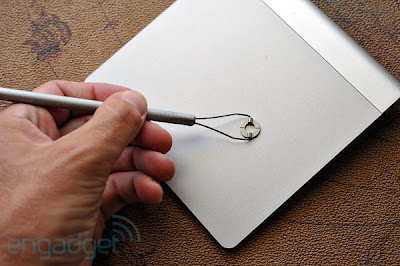 The pre-production oStylus model (which we used here) is partly machine-made, partly hand-made, and assembled by hand in the company's studio. There's obviously a lot of blood, sweat and tears going into this thing. It's extremely lightweight, but lovely to hold. You grasp it as you would a pen or pencil, and that makes drawing on capacitive surfaces a lesson in simplicity. The pivoting 'o' is smooth, and we were able to draw without forcing ourselves to compensate for the tool -- that's always a good sign. In general, it's just a beautiful device. Something you'd be proud to carry around with your capacitive tablet, and the well-thought-out design goes beyond aesthetics. It's essentially the perfect size and weight for drawing. So, is it all well and good? Not exactly.
The pre-production oStylus model (which we used here) is partly machine-made, partly hand-made, and assembled by hand in the company's studio. There's obviously a lot of blood, sweat and tears going into this thing. It's extremely lightweight, but lovely to hold. You grasp it as you would a pen or pencil, and that makes drawing on capacitive surfaces a lesson in simplicity. The pivoting 'o' is smooth, and we were able to draw without forcing ourselves to compensate for the tool -- that's always a good sign. In general, it's just a beautiful device. Something you'd be proud to carry around with your capacitive tablet, and the well-thought-out design goes beyond aesthetics. It's essentially the perfect size and weight for drawing. So, is it all well and good? Not exactly.If you watched the company's demo, you were probably shocked at just how well it performed. There are no smoke nor mirrors involved; in practice, it honestly does work that well. If you're positioned just so. What you can't see from the video is just how hard you have to focus to ensure that you're touching the capacitive surface with the entire bottom of the 'o.' There's a white vinyl surface on the underside of said 'o,' and that's the magic that allows it to interact with a capacitive screen; unfortunately, the whole darn 'o' isn't wrapped in this stuff. Frankly, we found the 'o' to be too large when used on smartphones, but it could've solved its own problem by wrapping the edges in the same white substance. That would've allowed us to use an edge to tap, rather than the entire bottom. Here's hoping that'll be added in the next iteration. Have a look below at our own interactions with the device.
All told, we're almost in love with the oStylus. When you've got the space and focus to ensure that 100 percent (not 90 percent, mind you) of the bottom is touching your capacitive screen, it works like a dream. It's deadly accurate and silky smooth, even on the Magic Trackpad, effectively turning Apple's newest mousing contraption into a makeshift Wacom tablet. But it's a tad too large for continued use on a smartphone panel, and the inability to use the edges to interact is a real bummer. We've no deep history in engineering, but the good news is that making more of the surface capacitive-compatible seems like an easy tweak. Also, at $75 (plus shipping), it's hard to recommend this pre-production model to all but the most affluent of designers. Of course, you'll get a numbered model with the creator's own name engraved in the handle (peek details shots of that in our gallery above), but the average Joe or Jane would probably be happier waiting for a mass market model at a fraction of the price.
Via Engadget